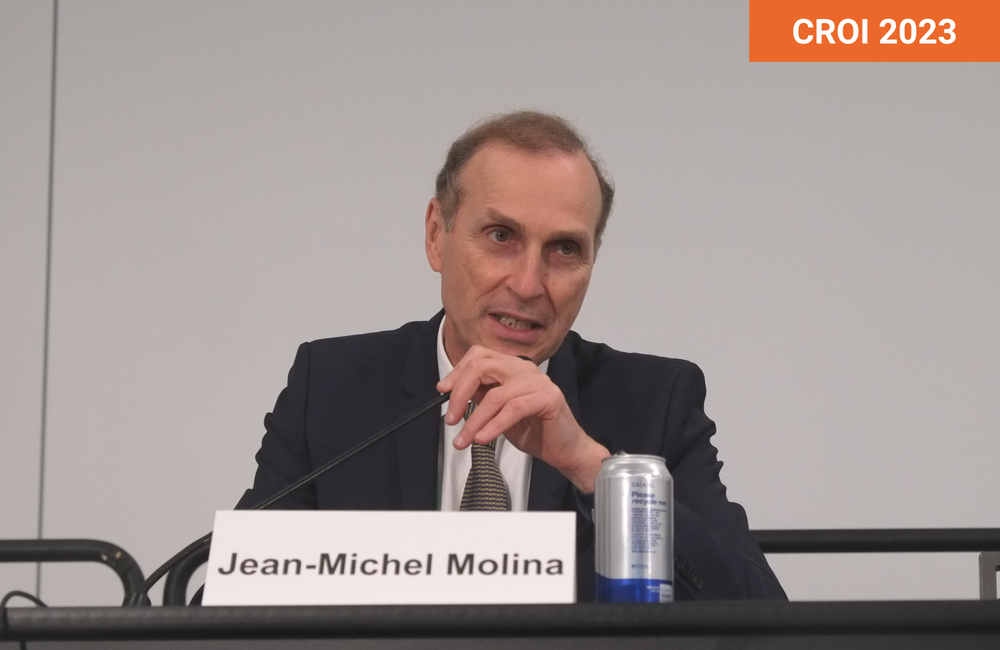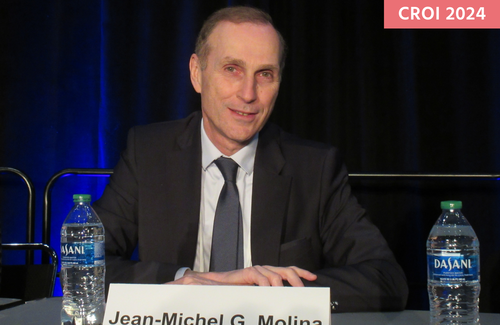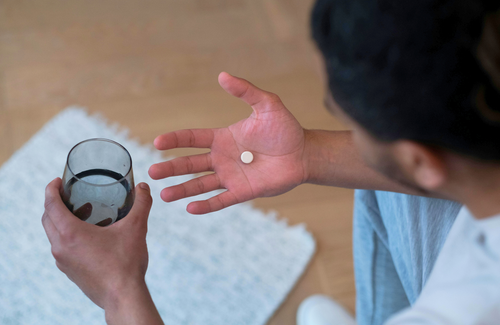
A vaccine against gonorrhoea halved the rate of repeated infections in gay and bisexual men, according to a study presented today by the French research agency ANRS at the 30th Conference on Retroviruses and Opportunistic Infections (CROI 2023) in Seattle.
“This is the first vaccine that shows some level of efficacy against a bacterial sexually transmitted infection,” principal investigator Professor Jean-Michel Molina of the University of Paris told aidsmap.
The DOXYVAC study, as its name implies, also looked at the effectiveness of taking the antibiotic doxycycline as post-exposure prophylaxis (‘doxyPEP’) against bacterial STIs in general. It cut the rates of chlamydia and syphilis by 88% and 87%. The antibiotic also “unexpectedly” cut the rate of gonorrhoea by 51%, independently of the effect of the vaccine.
The randomised phase of the DOXYVAC study was stopped in August 2022 when DoxyPEP, a US study, presented at the International AIDS Conference last year, found that doxycycline PEP cut the risk of chlamydia and syphilis by 87% in HIV-negative gay and bisexual men, and 75% in HIV-positive men. It also cut the risk of gonorrhoea by 55%.
This led advisors to the DOXYVAC study to request an early confidential analysis of the data, which showed that the results were already conclusive. They decided that it would be unethical to not offer all participants doxycycline, so the study was unrandomised, and as from last September all participants are being offered both the antibiotic and the vaccine until the end of 2023. Doxycycline will be offered to other clinic attendees but not the gonorrhoea vaccine, unless and until other studies underway in Australia and the US report similar or better results.
“The efficacy of doxycycline against gonorrhoea was unexpected”, Molina told aidsmap, “because in our original 2017 study among participants in the IPERGAY study, doxyPEP had no efficacy against gonorrhoea.” However, he added, the gonorrhoea bacterium would probably develop resistance to doxycycline with longer-term use of antibiotic prophylaxis. “Even when it works”, he said, “it’s a short-term answer to gonorrhoea. That’s why we need a vaccine.”
Background
Gay and bisexual men enrolled in the initial efficacy studies of HIV PrEP had very high rates of the bacterial STIs too: the cumulative incidence, or likelihood of catching any one of the three infections within a year, was 76% in the original IPERGAY study.
That led Molina to test the use of the antibiotic doxycycline as PEP among some of the IPERGAY participants. In that study, doxycycline PEP cut the rate of chlamydia and syphilis infection by over 70%. However, it had no effect against gonorrhoea.
It is thought that this is because 56% of gonorrhoea infections diagnosed at the start of the IPERGAY study had at least some degree of resistance against drugs in the tetracycline family, compared with only 20% in the Seattle and San Francisco residents in the US DoxyPEP study. (During the studies, gonorrhoea resistance increased to 66% in the French and 40% in the US study, showing how easily it develops.)
Because of this resistance problem. The DOXYVAC study added in the meningitis B vaccine 4CMenB (brand name Bexsero). The gonorrhoea and meningitis B organisms are of the same genus, Neisseria, and 4CMenB was already known to have modest efficacy against gonorrhoea.
The study and participants
The original trial design of DOXYVAC envisaged 720 participants. Because the study was terminated early, the full 720 were not recruited; 546 participants were randomised, and there are 502 in this analysis.
The 546 participants were randomised to receive the vaccine only (92 participants), doxycycline only (181), both interventions (181) or neither (92). All participants were also taking HIV PrEP.
Molina’s team wanted to measure the independent effects of both doxycycline and 4CMenB rather than their combined effects. So the same group of participants were randomised twice. This means that instead of analysing what happened to the four groups of people who had both, one, or neither of the interventions, there are two separate analyses; firstly, of participants who did and did not take doxycycline, and secondly, participants who did and did not have the vaccine. To complicate matters, while the vaccine group was split 50/50, twice as many got doxycycline as did not, i.e. a 67/33 split.
The vaccine was given as two shots, one at the start of the year-long study and the other two months later. DoxyPEP recipients were told to take two 100mg tablets of doxycycline no more than 72 hours after sex, and preferably within 24 hours.
Of the 502 people whose data were available for analysis, 332 received doxyPEP and 170 did not; 257 received the vaccine, while 245 did not. They were all cisgender gay and bisexual men with an average age of 39. Eighty per cent were White and 85% born in France.
They had very high baseline rates of STIs, defined as infections diagnosed in the last year. Sixty-eight per cent had had gonorrhoea, 50% chlamydia and 20% syphilis. Their average number of partners in the last three months was 10, with an average of five occasions of condomless sex in the last month. Eleven per cent had used chemsex drugs the last time they had sex.
DoxyPEP results
Men given doxyPEP reported that they had used PEP after 83% of the times they had sex as specified during the study period. The average time taken between sex and taking PEP was rather long – 27 hours. Six per cent reported side effects, all gastrointestinal such as nausea or stomach pain.
In the doxyPEP analysis, after a year, there were 36 syphilis and/or chlamydia infections in participants not allocated to PEP and 13 in men who did receive it. However, because there were twice as many men taking PEP as not taking it, and because some acquired multiple infections, these figures understate the true difference.
The more useful primary endpoint (measure of efficacy) was not the absolute number of infections, but rather the ‘time to first infection’, i.e. the proportion of participants who were diagnosed with either of the infections for the first time within the average follow-up time of nine months. This equated to an annual incidence of 35.4% in men not receiving PEP, but only 5.6% in men receiving PEP – only 16% as many. In other words PEP prevented 84% of the syphilis or chlamydia infections that might otherwise have happened.
Taking the two infections separately, PEP had 79% efficacy against syphilis and 89% efficacy against chlamydia.
PEP, as mentioned above, also had a more modest efficacy against gonorrhoea. There were 40 infections in men not on PEP and slightly more – 44 – in men on PEP but because there were twice as many men on PEP, this equates to a 41% annual incidence of gonorrhoea off PEP and a 20.5% incidence on it – 51% efficacy (there was also marginal efficacy against a fourth STI, mycoplasma genitalium).
Interestingly, the PEP only seemed effective in preventing anal or urethral gonorrhoea, but not throat infections.
There was some evidence that gonorrhoea acquired drug resistance, even during the relatively short follow-up time. At baseline, all participants who had had gonorrhoea and had cultures available for resistance testing (65 in all, or 15% of all gonorrhoea-positive samples) had some degree of resistance to drugs of the tetracycline class – but this low-level resistance did not stop the doxycycline working, and there was no high-level resistance that would.
High-level resistance was seen in gonorrhoea samples collected during the study – 19% in those not on PEP and 33% in those who were on PEP had it. However, this difference was not statistically significant as relatively small numbers of samples were tested for resistance – 37 in people not taking PEP and 21 in those taking it. The actual number of samples with high-level resistance was seven in each case.
In contrast, no resistance was detected in chlamydia samples. It’s impossible to do a phenotypic resistance test of syphilis, but Jean-Michel Molina says he thinks that it may be difficult or even impossible for both syphilis and chlamydia to acquire resistance mutations to tetracyclines in the same way (there have been a couple of reports of syphilis resistant to the macrolide drug azithromycin, sometimes used for treatment).
There was some evidence of increases in broader antibiotic resistance. At the start of the study, 1.8% of swabs taken for MRSA were positive in men allocated to PEP and 1.2% in men not receiving it. After a year this had increased to almost 10% in men on PEP versus 5% in men not on it. However, this again represents a small number of resistant samples.
Vaccine results
No serious adverse effects due to the vaccine were reported, though 35% of men receiving the vaccine reported familiar post-vaccine feelings such as fever, headache or weakness.
There were 49 first-time gonorrhoea infections, 32 in men not given the vaccine, versus 17 in men given it. This equated to 19.7% annual incidence without the vaccine, and 9.8% with it – coincidentally, exactly the same 51% efficacy as doxyPEP. Because some men acquired more than one infection, cumulative infections were also counted.
There were 90 diagnoses altogether – 54 in men not given the vaccine and 36 in men given it. This represents annual incidences of 30% and 20%, respectively, or an efficacy in preventing cumulative infection of 33%, which may indicate that the vaccines’ efficacy tails off over time.
In terms of site of infection, because there were smaller numbers of points in the data, there was no one site where the vaccine made a statistically significant difference, but there was a trend towards significance against infections in the throat, with 17 in men not given the vaccine versus eight in men given it (p = 0.073).
Next steps
What happens next? Professor Molina doesn’t see guidelines immediately endorsing the gonorrhoea vaccination after one study, or at the efficacy observed.
“Besides which, Bexsero is expensive,” he says (in the US, the Centers for Disease Control and Prevention gives its list price as $211.32 per dose). “We need to find out what its duration of protection is, and whether and when you might need a booster. And we need to do modelling to establish the effectiveness and cost-effectiveness of gonorrhoea vaccination.
“Also, this vaccine is tailored to the meningitis B bacterium. If studies consistently prove efficacy, then there will be an incentive to develop one more specific to the gonorrhoea organism.”
Molina J-M et al. ANRS 174 DOXYVAC: an open-label randomized trial to prevent STIs in MSM on PrEP. Conference on Retroviruses and Opportunistic Infections, Seattle, abstract 119, 2023.


